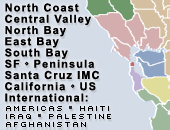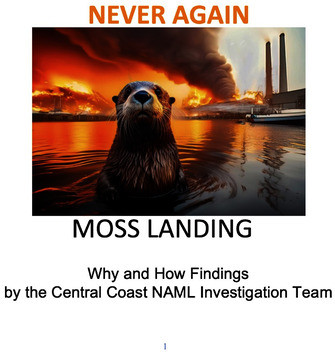From the Open-Publishing Calendar
From the Open-Publishing Newswire
Indybay Feature
Santa Cruz Indymedia
Environment & Forest Defense
Government & Elections
Health, Housing & Public Services
Never Again Moss Landing Releases Report on Vistra Battery Plant Fire
The Never Again Moss Landing (NAML) Stakeholder Group, which is comprised of over 4,900 citizens, has released a new report titled, "Why and How Findings by the Central Coast NAML Investigation Team." The report details findings of their 120-day investigation into how and why the Vistra Energy battery facility at the Moss Landing Power Plant caught fire and destroyed itself during the period of January 16-22, 2025. "We are not volunteer stakeholders," the report states. "We were forced into it in late-January 2025 because our families, homes, farms, boats, and businesses, as well as the local sea and estuary were exposed to the massive pollution cloud carrying heavy metal, dioxins, and PFAs that washed across our Central Coast communities while the Vistra indoor lithium battery storage building burned to the ground." (Photo: Moss Landing Battery Plant Fire on January 16, 2015. This image by Guy Churchward is licensed under CC BY 2.0.)
SUMMARY FINDINGS (For a complete list of NAML's findings, read the full report attached below as a pdf file)
Six Operator-level Findings:
* Vistra built and operated the largest indoor lithium battery storage facility in America from December 11, 2020 until January 16, 2025 where it stored 100,000 heavy-metal lithium-ion nickel-manganese-cobalt batteries on the 1st and 3rd floors of its Phase-1 building.
* Multiple pieces of evidence verify that Vistra double-stacked & densely-packed batteries and row-units along the full length of the Phase-1 upper 3rd floor
* Storage facility operator (Vistra) installed and operated a single-building, high-quantity, indoor storage layout, that was prone to completely burn up all the batteries on a floor if uncontrolled thermal runaway erupted.
* The double-stacked densely-packed row-unit layout made it easier for thermal heating to jump across aisles and harder for the building’s suppression system to suppress.
* On January 16, 2025, the storage building’s suppression system failed to suppress and its containment system failed to contain. The suppression system either did not exist, did not rapidly initiate, was inadequate for the number of batteries exposed to thermal runaway heat, or it failed to operate.
* Vistra’s Phase-1 Moss Landing indoor battery storage facility completely burned down after only on-fifth of its planned 20-year operating lifespan, with the complete loss of the building and its stored inventory.
Four Operator Risk Findings:
* Vistra followed a high-risk storage layout and operation strategy that failed and cost the company dearly.
* Vistra willingly chose to position its industrial operations in a coastal area, thus placing the Monterey Bay Coastal environment, tourism, agriculture, and citizens at high risk of being harmed.
* Vistra failed to protect and thus endangered the Monterey Bay Coastal environment, businesses, homes, and people from a vaporized heavy metal pollution cloud and surface residue.
* CEO Morgan was correct that Vistra’s Moss Landing project would, as it is now, serve as the model for utility-scale battery storage for years to come. Unfortunately, the project became a model for what not to do as of January 16, 2025, when the “first” and largest single-building high-quantity, indoor battery storage facility in America burned down.
Eight Regulator-Level Findings:
* California’s PUC Regulator before the Vistra disaster and still now, has not issued installation, safety, and operating codes for single-building, high-density, indoor, lithium battery storage facilities, nor any codes for dealing with single-building thermal runaway events at the row-unit and building level.
* Regarding the Vistra public utility, the PUC regulator failed at its mission to protect the Central Coast people, businesses, and environment because it allowed too much do-what-you-want self-policing by the Vistra storage operator.
* The PUC knew or should have known that Vistra installed and operated a single-building, high-risk high-quantity, indoor storage layout, that was prone to completely burn up all the batteries on a storage floor if uncontrolled thermal runaway erupted.
* The PUC allowed Vistra to operate and put at risk Federal & State coastal sanctuaries/reserves, the Salad Bowl of America, Monterey Bay area tourism, and ten Central Coast cities/towns, including being built in a Tsunami flood zone.
* The PUC arrived at the huge Vistra Battery fire unprepared for such a fire to include not having a drone surveillance policy or plan to gather aerial samples of lithium battery hazards released during a lithium battery fire.
* No California state regulator or agency made any attempt to sample downwind vapor conditions for heavy metal and dioxin exposure beyond the fire site. Nor did they sample soil and residue samples inside or outside the perimeter of Vistra’s industrial site.
* State regulators failed to gather and report heavy metal sampling data that might show dangers to the public and environment for “hazardous materials release” of heavy metals, dioxins, PCBs, chlorinated compounds, or polyaromatic hydrocarbons (PAHs) in the Moss Landing fire’s vapor/cloud during the Vistra disaster. The only sampled for oxygen dioxide and hydrogen fluoride.
* Large lithium battery storage fires are common in California; they have occurred annually since April 2022.
For more information, visit the Never Again Moss Landing website:
https://neveragainmosslanding.org/
Six Operator-level Findings:
* Vistra built and operated the largest indoor lithium battery storage facility in America from December 11, 2020 until January 16, 2025 where it stored 100,000 heavy-metal lithium-ion nickel-manganese-cobalt batteries on the 1st and 3rd floors of its Phase-1 building.
* Multiple pieces of evidence verify that Vistra double-stacked & densely-packed batteries and row-units along the full length of the Phase-1 upper 3rd floor
* Storage facility operator (Vistra) installed and operated a single-building, high-quantity, indoor storage layout, that was prone to completely burn up all the batteries on a floor if uncontrolled thermal runaway erupted.
* The double-stacked densely-packed row-unit layout made it easier for thermal heating to jump across aisles and harder for the building’s suppression system to suppress.
* On January 16, 2025, the storage building’s suppression system failed to suppress and its containment system failed to contain. The suppression system either did not exist, did not rapidly initiate, was inadequate for the number of batteries exposed to thermal runaway heat, or it failed to operate.
* Vistra’s Phase-1 Moss Landing indoor battery storage facility completely burned down after only on-fifth of its planned 20-year operating lifespan, with the complete loss of the building and its stored inventory.
Four Operator Risk Findings:
* Vistra followed a high-risk storage layout and operation strategy that failed and cost the company dearly.
* Vistra willingly chose to position its industrial operations in a coastal area, thus placing the Monterey Bay Coastal environment, tourism, agriculture, and citizens at high risk of being harmed.
* Vistra failed to protect and thus endangered the Monterey Bay Coastal environment, businesses, homes, and people from a vaporized heavy metal pollution cloud and surface residue.
* CEO Morgan was correct that Vistra’s Moss Landing project would, as it is now, serve as the model for utility-scale battery storage for years to come. Unfortunately, the project became a model for what not to do as of January 16, 2025, when the “first” and largest single-building high-quantity, indoor battery storage facility in America burned down.
Eight Regulator-Level Findings:
* California’s PUC Regulator before the Vistra disaster and still now, has not issued installation, safety, and operating codes for single-building, high-density, indoor, lithium battery storage facilities, nor any codes for dealing with single-building thermal runaway events at the row-unit and building level.
* Regarding the Vistra public utility, the PUC regulator failed at its mission to protect the Central Coast people, businesses, and environment because it allowed too much do-what-you-want self-policing by the Vistra storage operator.
* The PUC knew or should have known that Vistra installed and operated a single-building, high-risk high-quantity, indoor storage layout, that was prone to completely burn up all the batteries on a storage floor if uncontrolled thermal runaway erupted.
* The PUC allowed Vistra to operate and put at risk Federal & State coastal sanctuaries/reserves, the Salad Bowl of America, Monterey Bay area tourism, and ten Central Coast cities/towns, including being built in a Tsunami flood zone.
* The PUC arrived at the huge Vistra Battery fire unprepared for such a fire to include not having a drone surveillance policy or plan to gather aerial samples of lithium battery hazards released during a lithium battery fire.
* No California state regulator or agency made any attempt to sample downwind vapor conditions for heavy metal and dioxin exposure beyond the fire site. Nor did they sample soil and residue samples inside or outside the perimeter of Vistra’s industrial site.
* State regulators failed to gather and report heavy metal sampling data that might show dangers to the public and environment for “hazardous materials release” of heavy metals, dioxins, PCBs, chlorinated compounds, or polyaromatic hydrocarbons (PAHs) in the Moss Landing fire’s vapor/cloud during the Vistra disaster. The only sampled for oxygen dioxide and hydrogen fluoride.
* Large lithium battery storage fires are common in California; they have occurred annually since April 2022.
For more information, visit the Never Again Moss Landing website:
https://neveragainmosslanding.org/
Add Your Comments
We are 100% volunteer and depend on your participation to sustain our efforts!
Get Involved
If you'd like to help with maintaining or developing the website, contact us.
Publish
Publish your stories and upcoming events on Indybay.
Topics
More
Search Indybay's Archives
Advanced Search
►
▼
IMC Network





